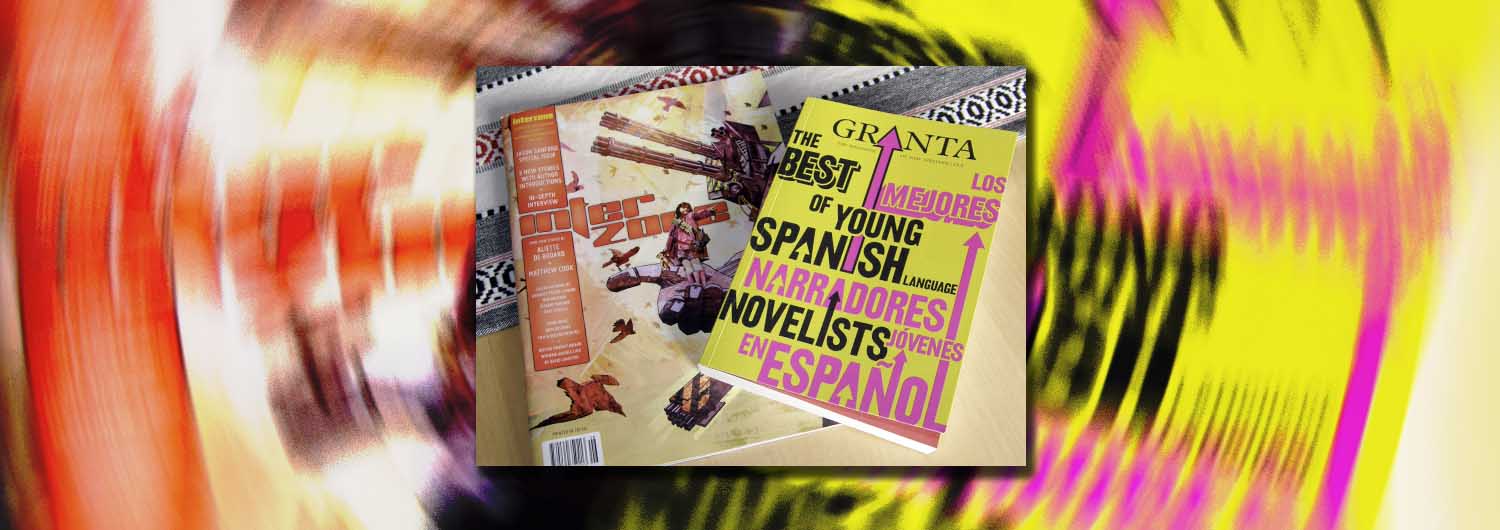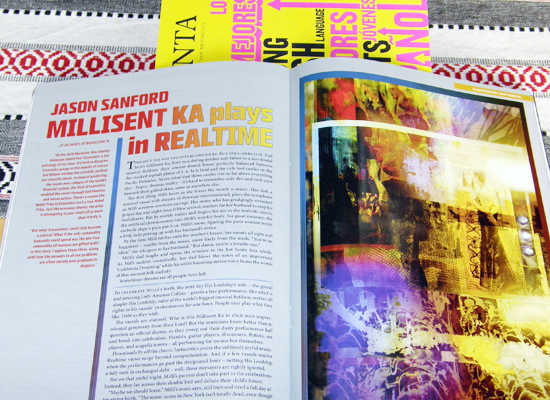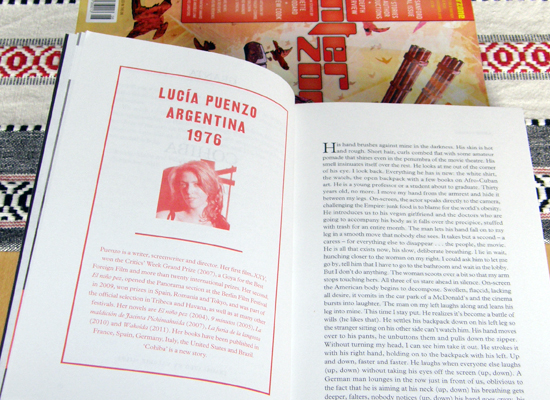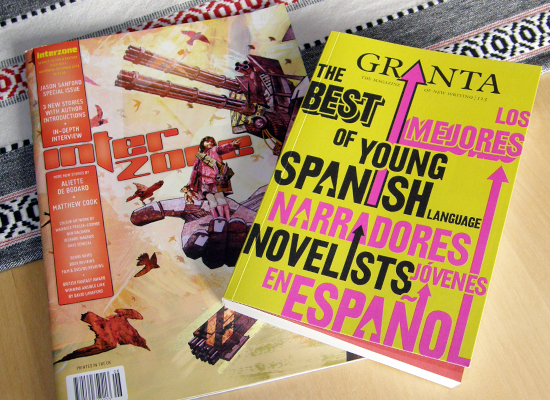A comparative review of short stories “Millisent Ka Plays in Realtime” by Jason Sanford and “Cohiba” by Lucia Puenzo.
On Wednesday last week, the post brought the latest edition of Granta number 113: “The Best of Young Spanish Language Novelists”. Granta is launching a Spanish language edition and marking the occasion (and promoting it) by publishing in English translation the contents of the first Spanish edition.
As it happens I had just read the last story in my most recently received edition of Interzone. I had nothing else in the pipeline so was able to pick up Granta and start reading directly.
Granta versus Interzone
For the uninitiated I should say that, at present, I subscribe regularly to just these two literary magazines. Granta according to its tagline is “The Magazine of New Writing”. It publishes a variety of literature, much in the belles-lettres genre, and reportage (and generally, though not in this edition, one piece of photo-journalism). Granta is a nice thick paperback, comes quarterly, and I’ve been subscribing since the 80s, since number 4. (Though there was that long hiatus after I had a falling out by post with the former editor, Bill Buford.)
Interzone, by contrast, is a magazine of the science fiction and fantasy genres. Almost Britain’s most successful magazine ever, in the field. (In saying this, one is always aware of New Worlds which hovers somewhere on the edge of consciousness in an Oort Cloud of the mind.) Interzone was started by people I knew when I was a student. I’ve subscribed without a break since the first edition. Interzone is also a good deal thinner than Granta. On the other hand, it comes bi-monthly.
So, with the last story in Interzone still reverberating, I picked up Granta and read the first story. Interesting contrast, interesting similarity in my reaction.
The Interzone story was “Millisent Ka Plays in Realtime” by Jason Sanford; the Granta story was “Cohiba” by Lucia Puenzo (translated by Valerie Miles).
A feudal future and a time-warp
Now, there’s not a lot on the surface that links these two stories, beyond the fact that both circle around creativity and are set in environments in which creative artists (might) exist. The authors are of a similar generation. Both are Americans (Sanford from the USA, Puenzo from Argentina). Both are successful in their respective fields, but I’m not sure that’s relevant. They both address current concerns, even though “Milliscent Ka” is set in a new-feudal future Los Angeles while “Cohiba” is in the very recent past. (And set in a modern-day Cuba which, inevitably I suppose, feels trapped in a time-warp.)
In “Milliscent Ka” newborn children are deliberately infected with additional, genetically engineered DNA, which allows a kind of internal bookkeeping. Every expense one incurs in life is recorded as debt in ones DNA; debts are repaid by indentured time-service to ones patron.
Milli … learns to play a viola donated by the Lady Lord … only 10 seconds of debt per day … and she learns to read in the donated school, a few minutes of debt for a day’s learning, and she plays basketball on the courts, five seconds of debt a game …
It’s not an attractive future, but it doesn’t seem implausible either. The situation is well set up and the fictional (science-fictional) economic premise on which Millisent Ka’s society is based is well established. To begin with, at least, Jason Sanford manages to avoid the common information-dump pitfall that traps so many SF writers. (The necessity to explain the complex scientific/pseudo-scientific premise on which the society of the story is grounded leads too many SF writers – and film-makers – into interminable exposition.) I got quite excited about this story and enjoyed it, too – for more than the first half.
Film festival
In “Cohiba” we follow the narrator (who may be an avatar of Lucia Puenzo since she is obviously some sort of a film writer) around a film festival and masterclass in Havana. In the first scene she is in a crowded movie theatre watching a film that could be Supersize Me. The man sitting next to her opens his flies and masturbates, ejaculating on the back of the seat in front of him (and on the hair of the person sitting there). It certainly caught my attention. The man, whose name we learn is Cohiba, appears to be stalking the narrator, but ends up with “the Brasileira”, her roommate from the masterclass course.
This story is wonderfully descriptive of the experience of rushing from venue to venue of the festival in company with the narrator’s masterclass coursemates, the Brasiliera, oozing sex, the Basque with one leg shorter than the other, the giant Hungarian whose “stories are as exuberant as her body”. The crowds, sweat and smell of Cuba are well evoked. There’s humour too, for example in the narrator’s response to the maestro.
Garcia Marquez is already seated at his desk. The Argentinean woman who arrived late, he says. I want today’s big idea. I tell him the story of a student who – for lack of ideas – decides to murder her maestro. He interrupts me immediately …
Malignant
But, as the story progresses, I realise Cohiba is supposed to be a malignant character. I begin to pick up on the author’s belief that she’s describing an Havana suffused with menace. The problem is, I can’t feel it. The final sentence of the story is, I’m sure, supposed to echo in the reader’s mind, but my reaction was more of a mental shrug.
Much the same shrug, actually, as the one I gave at the end of “Milliscent Ka”.
Looking for a reason for my disappointment in each case, I come back to the story, the plot, the “big idea”.
There’s one fundamental difference between the two stories. For all the brilliance of his original idea, Jason Sanford is writing a commercial story. Lucia Puenzo is writing a self-consciously “literary” story. (Not to say she doesn’t want to sell it, but to a very different market.)
Jason Sanford has found a “big idea” – in fact he has by my count at least four – but he’s trying to shoe-horn them all into the same small space. The format is wrong.
Lucia Puenzo makes fun of the “big idea”, but she has one nonetheless (possibly two or three). For some reason, though, she can’t convey them. (To be fair, it’s possible the translator is letting her down, but the descriptive passages are otherwise so good, there are no rough edges that I can find, the language flows. No, I think this is a probably a faithful translation. The problem isn’t there.)
Millisent’s big ideas
In “Millisent Ka” it seems at first that the big idea is up at the front with the chromosome-encoded debt, but this is just the premise for the society in which Milli lives. After a bit you discover the big idea is actually that a genetic mutation in Milli herself erases her debt. She is able to take other people’s debt on to herself, and then allow her body to erase it. In this way she can set people free. This makes her a threat to the established social fabric of her world. She is found out and condemned to death.
Because this is a commercial story, though, Jason Sanford just can’t allow himself to end on a downbeat. It turns out that Millisent’s mutation is not natural but contrived, and by the same geneticist who devised the original debt-encoding DNA. Furthermore, the geneticist is still alive. (This immediately, and incredibly, foreshortens the period of time it must have taken for the society described to have come into being.) Beyond this, the geneticist is one of the feudal Lords and she devised the genetic mutation as a way to retain economic control.
Milliscent is a guinea pig. But she is also The One without which many a commercial SF tale cannot exist (see The Matrix). At the same time, she is also a damsel in distress. She has to be rescued by a knight in shining armour. Sorry, by her boyfriend, who she has cleared of debt, but who voluntarily returns to servitude to save her life. And his selfless act combined with the musical talent that Milli suddenly, mysteriously acquires (after having been described as a mediocre player throughout the story) causes the feudal lord to have a change of heart and everything ends happily ever after.
Cohiba’s big idea
In “Cohiba” the big idea is that Cohiba, who teaches at the University, is a dangerous sexual predator. He’s probably a murderer too, and quite possibly a paedophile with an unhealthy interest in his own daughter. I’m sure a commercial writer (Jason Stanford, perhaps) would be able to make an episode of an American TV criminal series out of all this, but Lucia Puenzo is determined not to be commercial. The result is that her story – in stark contrast to all her incidental description and characterisation – falls completely flat. I cannot believe in Cohiba as anything more than a 30 year old man with a retarded, adolescent interest in sex. At one point: Fear creeps up in the middle of two coffee plantations, but nothing otherwise builds or sustains fear in the story.
In the eyes of this reader, both these stories fail. Puenzo’s because she is so keen to avoid being commercial that she fails to build the story successfully to the punch line. While Sanford’s story collapses under the weight of its ideas and the author’s desperate efforts to provide an upbeat ending.
Not lost
Fortunately, all is not lost. Traditionally, SF short stories are testing grounds for ideas that may then be developed in novels. Some of the ideas in “Millisent Ka” are well-worth pursuing and exploring. If Sanford can block his ears to the siren song of the formula ending, the novel might actually be worth reading. And suppose he could develop the novel in collaboration with a literary writer (Lucia Puenzo, for example), what a fascinating co-operative endeavour that might be!
Meanwhile, Lucia Puenzo is not just a “Young Spanish Language Writer”. She’s also a movie director with at least two internationally acclaimed films to her credit (XXY and El niño pez). I can well imagine this story as a film. Perhaps in that context – in co-operation with a good actor – she would be able to let herself infuse the character of Cohiba and the city of Havana with the menace they so singularly lack in the story.
Links to follow
Granta http://www.granta.com/
Interzone http://ttapress.com/interzone/
Luccia Puenzo (on Wikipedia) http://en.wikipedia.org/wiki/Lucía_Puenzo
Jason Sanford http://www.jasonsanford.com/





I went
I saw
I LIKED!!
Thank you, Bill!
Good website. I love this post. Thank you 🙂
Thanks, Claude. Have you read either story? Either magazine?